

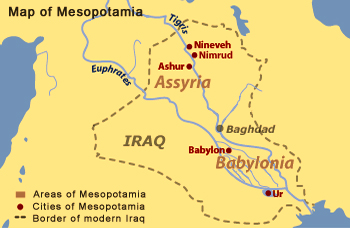 In a region that gets little rainfall, access to the water from these two rivers has always been crucial. About 3500 BCE, the rivers having flooded every year, people were building dams and growing increasing quantities of food in the area's rich soil. Mesopotamians built canals to distribute water throughout the land, uniting thousands of villagers. People raised cattle and sheep. The plough was invented here, and the potter's wheel evolved into the wheels that let carts transport goods to markets, and to carry officials in ceremonial processions. The Mesopotamians' need to control the water for these uses gave strength to their political leaders, and led to the development of the city-state — among them were Ur, Ashur, Ninevah, Nimrud, Emech, Kish, Umma, Erech, Lagash, Tello, Nippur, Larsa, and Babylon.
In a region that gets little rainfall, access to the water from these two rivers has always been crucial. About 3500 BCE, the rivers having flooded every year, people were building dams and growing increasing quantities of food in the area's rich soil. Mesopotamians built canals to distribute water throughout the land, uniting thousands of villagers. People raised cattle and sheep. The plough was invented here, and the potter's wheel evolved into the wheels that let carts transport goods to markets, and to carry officials in ceremonial processions. The Mesopotamians' need to control the water for these uses gave strength to their political leaders, and led to the development of the city-state — among them were Ur, Ashur, Ninevah, Nimrud, Emech, Kish, Umma, Erech, Lagash, Tello, Nippur, Larsa, and Babylon.
Ur, near today’s Persian Gulf, became a major storage center where goods were distributed by ship.  These and caravans across the lands to the north and west carried the treasures of many lands: silver, iron and lead from present day Turkey, timber from Syria, semiprecious gemstones such as lapis lazuli from Afghanistan, and gold and incense from Egypt and Arabia. The Mesopotamians left us the earliest written records known, when they devised a system of
These and caravans across the lands to the north and west carried the treasures of many lands: silver, iron and lead from present day Turkey, timber from Syria, semiprecious gemstones such as lapis lazuli from Afghanistan, and gold and incense from Egypt and Arabia. The Mesopotamians left us the earliest written records known, when they devised a system of cuneiform writing (marks on clay tablets made by impressing this plastic material with wedge-shaped ends of carved sticks). They invented arithmetic (useful in keeping records of sales and purchases of goods), built schools, businesses, temples, palaces, workshops, and devised a system for the collection of taxes.
Mesopotamia was the setting for such famous Bible stories as the Garden of Eden, the Tower of Babel (Babylon), and the journey of Abraham from the city of Ur.
We actually know little about the Mesopotamians' religion, but much of what we know was learned from their poetry -- "The Epic of Gilgamesh" is their most imortant poem — and from the History of Herodotus (Anatolian Greek, fifth century BCE). The Sumerians were a religious people and had what is called a theocratic culture. They believed gods ruled the earth and that men were created to serve them.  They practiced tithing: 10% of their goods went to the gods. The leader of each city-state was considered a local god who talked to the head gods. Ur, like every other city-state, had its own head god whose earthly home was the city’s
They practiced tithing: 10% of their goods went to the gods. The leader of each city-state was considered a local god who talked to the head gods. Ur, like every other city-state, had its own head god whose earthly home was the city’s ziggurat. These temples were built up in layers and would tower above the flat land of the area, reaching to the heavens. The cella, the very top of the ziggurat, is where the communication would take place between the king and the gods. Elaborate rituals would take place at these temples with priests, servants, and worshippers coming and going to take care of the god’s every wish. The ziggurat at Ur was built around 2100 BCE to honor the moon god Nanna.


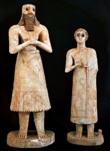
The statues found at the Abu Temple in Tell Asmar from c. 2700 BCE are fine examples of the way Sumerian sculpture is typically based on cones and cylinders — arms and legs like pipes, skirts smooth and round, flaring out at their bottoms. Faces are dominated by very large eyes; but, for reasons we might take for granted, artists of many cultures have placed emphasis on eyes.
The sizes of entire figures were also determined by a hieratic imaging system — the most important people were made the tallest.  In the same vein, a beard on a figure signifed a man in a powerful position.
In the same vein, a beard on a figure signifed a man in a powerful position.
Two-dimensional depictions generally show figures' heads, legs, and feet in profile, while their shoulders and torso are shown frontally, as in this Sumerian painting of a man holding fish, from the Royal Tombs at Ur.
From about 2300 BCE, wars shaped the future of Mesopotamia's peoples. The Assyrians in the northern valley of the Tigris River began as a community of peaceful farmers and traders. Their wealth and natural resources of copper ore (for arms and tools), limestone, alabaster and marble eventually made them targets for the envy of other peoples. The Hammurabi of Babylon, among others, pressed for control of the Assyrians, and eventually Assyrians mobilized fearsome armies to battle them, among other enemies.
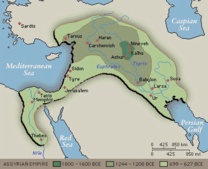
A map of the Ancient Assyrian Empire at three different periods — at its beginnings, little more than the city-state of Ashur, about 1800-1600 BCE; then when it had gained control of the northern half of the Tigris and Euphrates and access to the Mediterranean, 1244-1208 BCE; and finally, when the Assyrians had conquered the entire "Fertile Crescent," including Egypt as far as Thebes, 699-627 BCE.
Assyria's art proudly portrays its pillaging, tearing down cities, and the killing and submission of its enemies — partly to intimidate those who might consider fighting back, and also because Assyrians believed that if their conquests passed the tests of the prophets and omens, their achievements would have the blessing of the gods. Ashurnasirpal II at War depicts a successful battles in which a deity flies above this favored king. The Assyrian Empire reached the height of its size and power in 668-627 BCE under Ashurbanipal. Then, under a series of weak rulers, Mesapotamia fell to the Babylonians.
Examples of Mesopotamian art:

Mesopotamia, Uruk, Document Consisting of Ideograms, late 4th-early 3rd millennium BCE, Uruk Period (3500-3100 BCE), stone, 4.3 x 2.3 cm, Hermitage Museum, St. Petersburg, Russia. See See text.
| Mesopotamia | Egypt | Israel / Palestine | |
| 3500-3100 BCE | Uruk | ||
| 3100-2900 BCE | Jemdet-Nasr | 3100-2686 Early Dynastic | 3150-2200 Early Bronze |
| 2900-2700 BCE | Early Dynastic I | ||
| 2700-2500 BCE | Early Dynastic II | ||
| 2500-2300 BCE | Early Dynastic III | 2686-2200 Old Kingdom | |
| 2300-2150 BCE | Sardonic/Akkadian | ||
| 2150-2100 BCE | Guti | 2200-2040 1st Intermediate | |
| 2100-2000 BCE | Ur III | 2040-1786 Middle Kingdom | |
| 2000-1600 BCE 2000-1700 BCE |
Old Babylonian Old Assyrian |
2000-1200 Middle Bronze II | |
| 1600-1500 BCE | Dark Age | 1786-1558 2nd Intermediate |
|
| 1600-1050 BCE | Kassite/Middle Babylonian | 1558-1085 New Kingdom | 1100 "Conquest" |
| 1400-1000 BCE | Middle Assyrian | ||
| 1000-626 BCE | Neo-Assyrian | 1050-925 United Kingdom | |
| 625-539 BCE | Neo-Babylonian | 586 Exile | |
| 539-330 BCE | Persian/Achaemenid | 539 Return | |
| 330-65 BCE | Alexander and Seleucid successors | ||
| 250 BCE - 230 CE | Parthians (Arsacid) | ||
| 230-650 CE | Sassanian | ||
| 650 CE - present | Arab / Islamic |
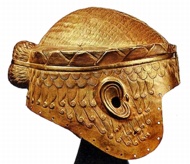
Mesopotamia, Royal Cemetery at Ur, Helmet of King Meskalamdug, c. 2400 BCE, repoussé gold, height 22 cm, greatest diameter 26 cm. The decoration of the helmet simulates the king's crown, hair, and ears. Holes drilled along the lower edges enabled the attachment of an inner helmet. This is one of many Mesopotamian objects that have recently been lost or stolen from Iraq's museums and have yet to be recovered. The Oriental Institute of the U of Chicago has posted a database of treasures that have been lost or stolen from Iraq. See arms and armor.

Mesopotamia, Mari, (Middle Euphrates): Temple of Ishtar, around 2400 BCE, Early Dynastic Period, Ebih-Il, the Superintendent of Mari, statuette, alabaster, height 0.52 m, Louvre. See portrait.
Mesopotamia, 23rd century BCE, Akkadian period, Cylinder-Seal of Sharkalisharri, chlorite, height 3.9 cm, Louvre. See cylinder and seal.

Mesopotamia, Cylinder seal and modern impression: hunting scene, 2250-2150 BCE, Late Akkadian period, chert, height 1.1 inches (2.8 cm), Metropolitan Museum of Art, NY.
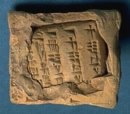
Mesopotamia (possibly Nippur; Ur III, c. 2044 BCE), Tablet in an Envelope, clay. A writer who wished to prevent tampering with a letter or another important text sometimes wrapped it, as this one was, in a clay envelope on which the writer re-recorded the text and applied a seal. Any effort to tamper with such a message would then be discovered.

Mesopotamia, Weight in the Shape of a Sleeping Duck, c. 2000 - 1500 BCE, carved limestone, length 35.2 cm — an unusually large size, private collection, Europe. The massive and highly stylized bird is shown with a plump body and flaring tail, and easily transcends its original and somewhat prosaic function. The head, on an elongated neck, is turned to rest on the back. The simplified contours combine with the tactile surface invite comparison to sculptures by Constantin Brancusi and other modern sculptors. See weight.
Mesopotamia, taken from Babylonia to Susa, Kassite period (1202-1188 BCE), Kudurru of Melishihu, gray limestone, 0.65 x 0.30 m, Louvre.
![]()
Assyria (Nimrud), A Winged Genius, 883-859 BCE, alabaster relief, Worcester Art Museum, MA.
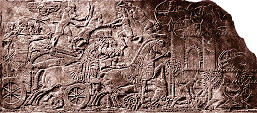
Mesopotamian, Nimrud, Ashurnasirpal II at War, c. 875 BCE, limestone relief, height 39 inches.
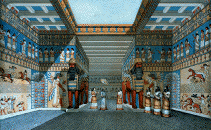 Such relief sculptures lined the halls and
Such relief sculptures lined the halls and throne room of the king's palace. Many depicted historical scenes of the king dominating enemies and wild beasts. The panels are arranged in friezes — an innovation of Assyrian sculptors and architects. In the battle scene above, the Assyrian king Ashurnasirpal attacks a fortified city whose walls are defended by archers. A winged deity above the king both protects him and blesses the event. The Assyrians clearly have the advantage. See history painting.
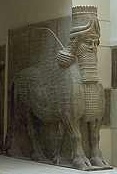
Mesopotamia, Khorsabad, palace of Sargon II of Assyria, Neo-Assyrian period, reign of Sargon II (721-705 BCE), Winged Assyrian Bull, gypseous alabaster, height 4.40 m, Louvre. This large statue is called a lamassu, meaning "protective spirit" in Akkadian. A pair of lamassu was usually placed at the doorways of Assyrian palaces to protect against evil spirits. Two painted ones can be seen above, in the throneroom at Nimrud.

Mesopotamia, Khorsabad, palace of Sargon II, Neo-Assyrian period, reign of Sargon II (721-705 BCE), Sargon II and a high official, gypseous alabaster relief, height 3.30 m, Louvre.

Mesopotamia, Khorsabad, the fortified city and palace of Sargon II (721-705 BCE), a contemporary rendering based upon archaeological excavations. This citadel and residential city was about a mile square. Its plan is symmetrical and as regimented as a military camp. The palace itself (at the upper-center of the picture) was built on a platform elevated 50 feet. The city's walls were built of mud brick (adobe) and faced with glazed brick. Stone was available but used for sculpture (see preceding example), not for building. The top of the walls was crenelated.
The ziggurat was built in seven levels, each 18 feet high, and each was painted a different color.
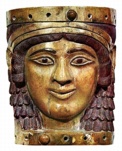
Mesopotamia, Nimrud, Head of a Woman, late 8th century BCE, ivory plaque, originally part of furniture. This piece is listed on the Oriental Institute's database of treasures that have been lost or stolen from Iraq.

Mesopotamia, Assyrian, Stele of Zincirli, 7th century BCE, height 3.46 m, Near-Eastern Museum, Berlin. See stele.
Mesopotamia (Babylon, Neo-Babylonian Period, Reign of Nabopolassar, 625-605 BCE), Cuneiform Cylinder of Nabopolassar Recording Repair of the City Wall of Babylon, clay, 3 7/8 x 2 1/16 inches (9.8 x 5.2 cm), Michael C. Carlos Museum, Emory U, Atlanta, GA.
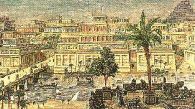
Persia, The Hanging Gardens of Babylon, sixth century BCE. Accounts indicate that the garden was built by King Nebuchadnezzar II, who ruled the city for 43 years starting in 605 BCE, and that he built them to cheer up his homesick wife, Amyitis. Medes, the land she came from was green, rugged and mountainous, and she found the flat, sun-baked terrain of Mesopotamia depressing, so the king decided to recreate her homeland by building an artificial mountain with rooftop gardens. The Hanging Gardens weren't actually "hanging", but instead were "overhanging" as in the case of a terrace or balcony. The Greek geographer Strabo, who described the gardens in first century BCE, wrote, "It consists of vaulted terraces raised one above another, and resting upon cubic pillars. These are hollow and filled with earth to allow trees of the largest size to be planted. The pillars, the vaults, and terraces are constructed of baked brick and asphalt. The ascent to the highest story is by stairs, and at their side are water engines, by means of which persons, appointed expressly for the purpose, are continually employed in raising water from the Euphrates into the garden." (Another image.)

Susa (Iran-Iraq border), Acheminide epoch, reign of Darius I (c. 510 BCE), Capital of a Column of the Audience Chamber (Apadana) in the Palace of Darius I, limestone, height 3.20 m, Louvre. See capital.

Syria or Iraq, Amphora-Shaped Jar, 12th century, ceramic, fritware, underglaze painted, 14 1/4 x 4 1/2 inches (36.2 x 11.43 cm), Los Angeles County Museum of Art. See amphora.
Also see map.
https://inform.quest/_art